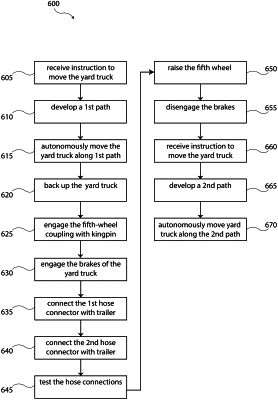| CPC B60W 60/0025 (2020.02) [B60D 1/62 (2013.01); B62D 53/125 (2013.01); B60W 2420/403 (2013.01)] | 11 Claims |

|
1. A method for operating an autonomous yard truck, the method comprising:
receiving an instruction to move the autonomous yard truck toward a specific trailer;
developing a first path for the autonomous yard truck to follow from a first location to the specific trailer through a work area that takes into account the geometry of the autonomous yard truck, wherein the first path has a first turning radius requirement and a first speed requirement;
after developing the first path, autonomously driving the autonomous yard truck along the first path to the specific trailer;
backing up the autonomous yard truck toward the specific trailer;
engaging a fifth-wheel coupling of the autonomous yard truck with a kingpin of the specific trailer;
engaging brakes of the autonomous yard truck;
deploying a deployable shade, wherein the deployable shade is coupled with a portion of a cab of the autonomous yard truck, and wherein the deployable shade screens sunlight from one or more sensors when deployed;
identifying a first trailer hose connector location on the specific trailer;
determining the location of a first hose connector on the autonomous yard truck;
engaging the first hose connector with a robotic arm;
moving the first hose connector from the first hose connector location to the first trailer hose connector location on the specific trailer with the robotic arm;
connecting the first hose connector with the first trailer hose connector;
testing the connection between the first hose connector and the first trailer hose connector;
raising a fifth-wheel coupling;
releasing the brakes;
receiving an instruction to move the autonomous yard truck and the specific trailer to a second location;
developing a second path for the autonomous yard truck and the specific trailer to follow from yard truck's current position at the specific trailer to the second location through the work area, wherein the second path is developed to take into account at least the geometry of the yard truck and the geometry of the specific trailer, wherein the second path has a second turning radius requirement that is wider than the first turning radius requirement and a second speed requirement that is slower than the first speed requirement; and
after developing the second path, autonomously driving the autonomous yard truck with the specific trailer along the second path to the location.
|